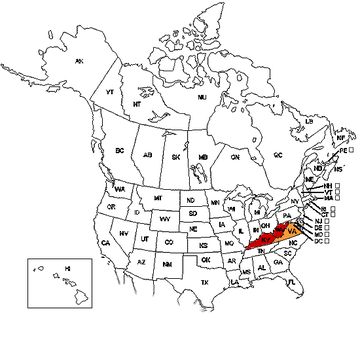Geography
Patera panselenus is a type of terrestrial snail, meaning it lives on land (Hickman, 2011). North America is the only place were this snail is found, mainly in the lower Cheat River (Hotopp, 2006). Specifically in North America, the West Virginia Bladetooth is found in select counties in West Virginia, Virginia and Kentucky (Dourson, 2010).
Counties in West Virginia: Boone, Cabell, Calhoun, Clay, Fayette, Greenbrier, Kanawha, Lincoln, Logan, McDowell, Mingo, Nicholas, Raleigh, Summers, Wayne, and Wyoming (Hotopp, 2006)
Counties in Virginia: Buchanan, Dickenson, and Wise (Hotopp, 2006)
County in Kentucky: Pike County (Hotopp, 2006)
Habitat
Within these counties, Patera panselenus is mainly found in environments where there is exposed damp rock features. The rocks are usually made of either sandstone, shale, or limestone (Hotopp, 2006). It is also common for Patera panselenus to live on ledges or mature forests on slopes (Hotopp, 2006). The environment along the Cheat River is very diverse. Some of species of plant life include many Quercus species (white oak), Oxydendrum arboretum (sorrel tree), Kalmia latifolia (mountain laurel), Nyssa sylvatica (black gum), and Liriodendron tulipifera (tulip tree) (Hotopp, 2006). Hotopp (2006) also reported that Patera panselenus is distributed sporadically throughout these counties. Meaning there are land features that break up pockets where Patera panselenus inhabits along the lower Cheat River Canyon.
Patera panselenus also interacts with other snail species such as Triodopsis platysayoides in some locations (Hotopp, 2006). According to Hotopp (2006), Triodopsis platysayoides is a rare speices that needs conservation. All the more reason to keep this piece of land safe from destruction. Other species are also located in surrounding microhabitats such as Patera appressa (Dourson, 2010).
